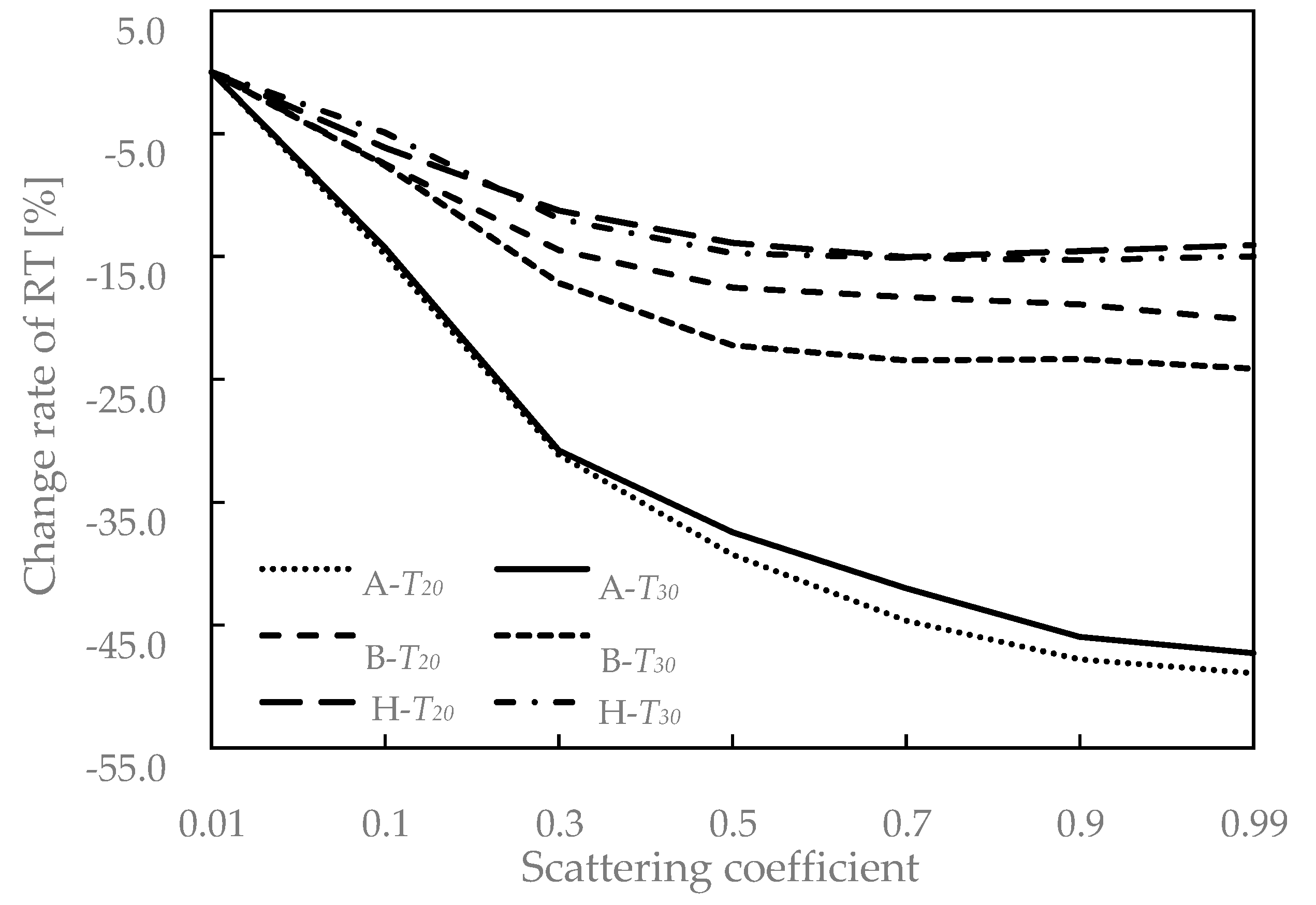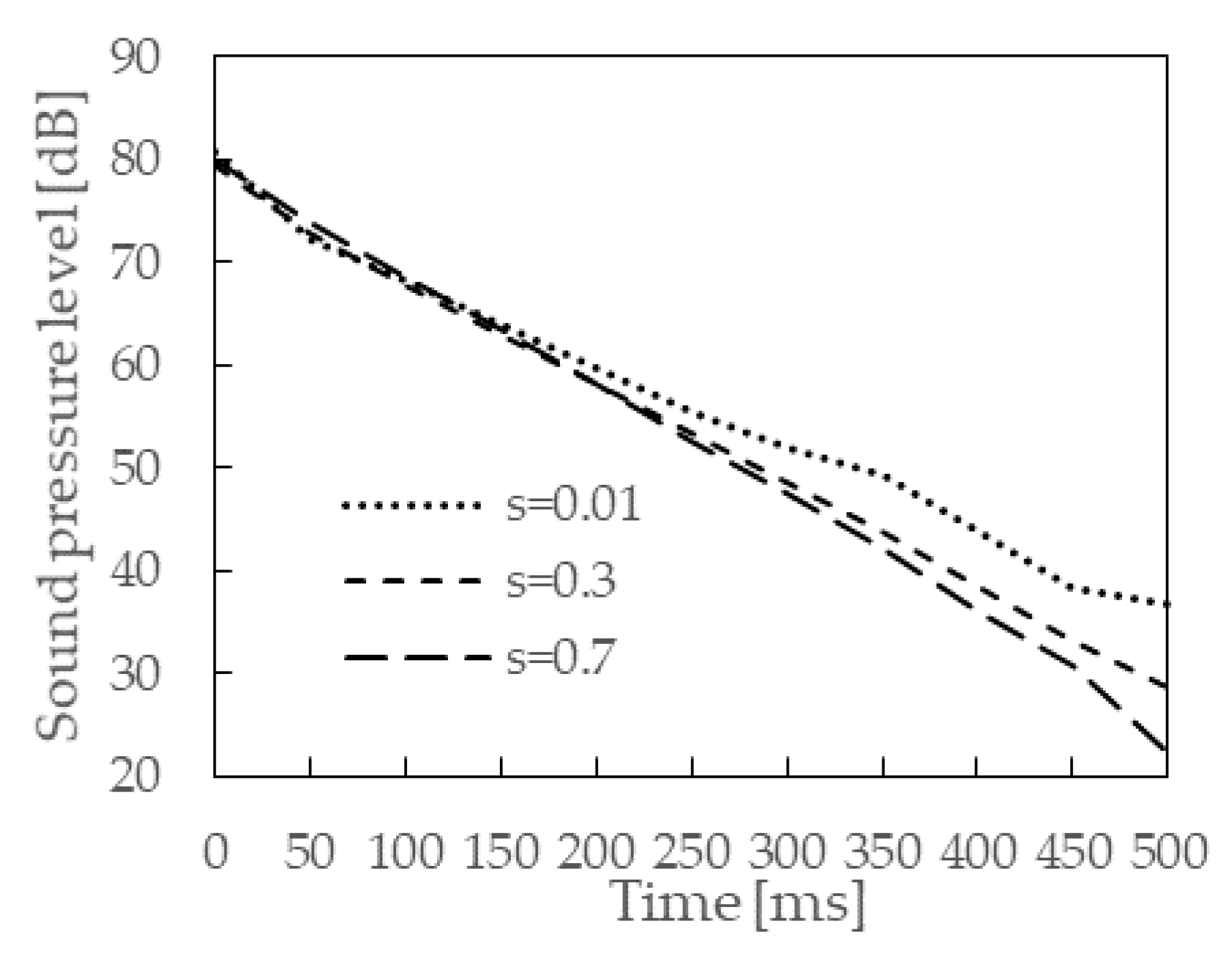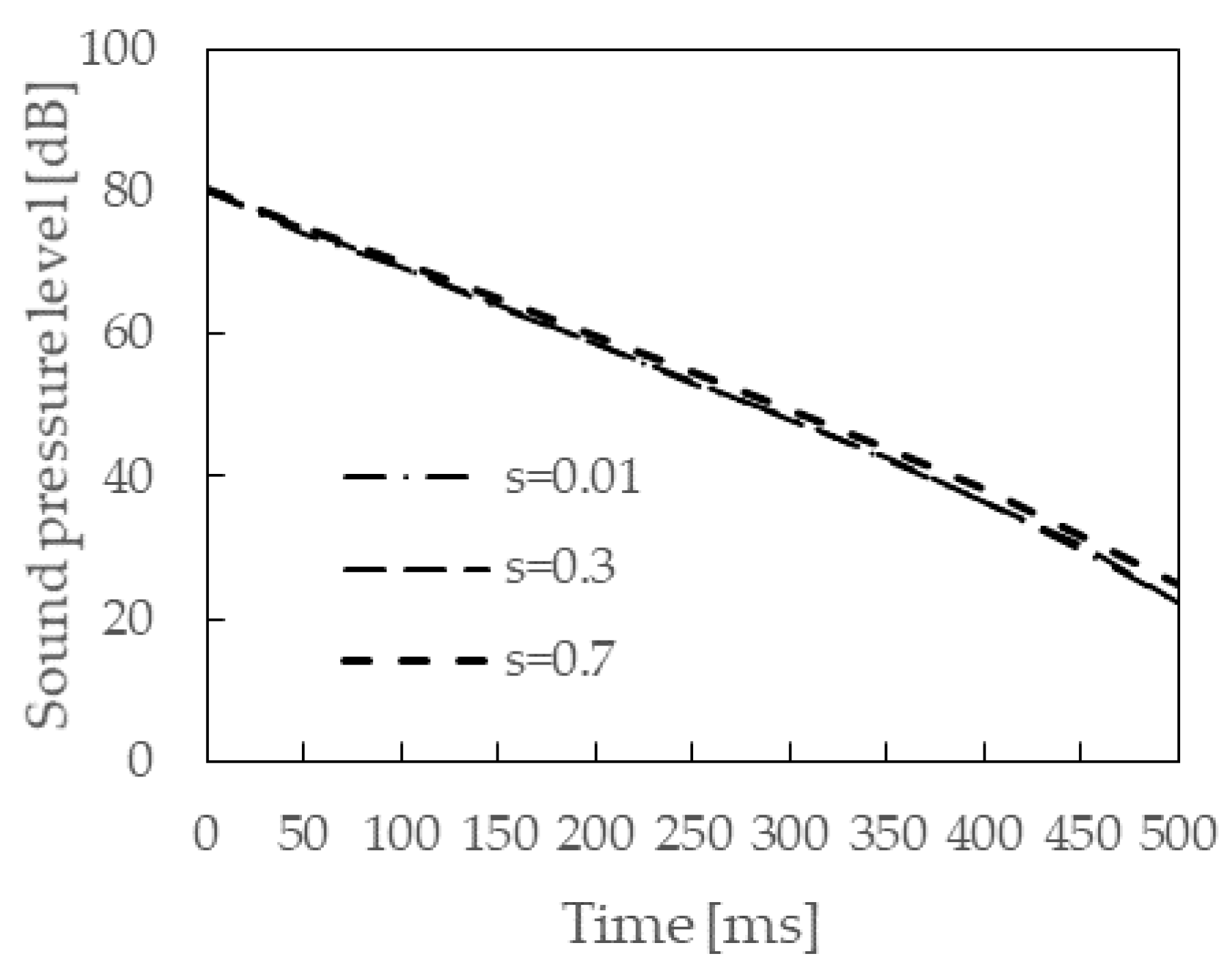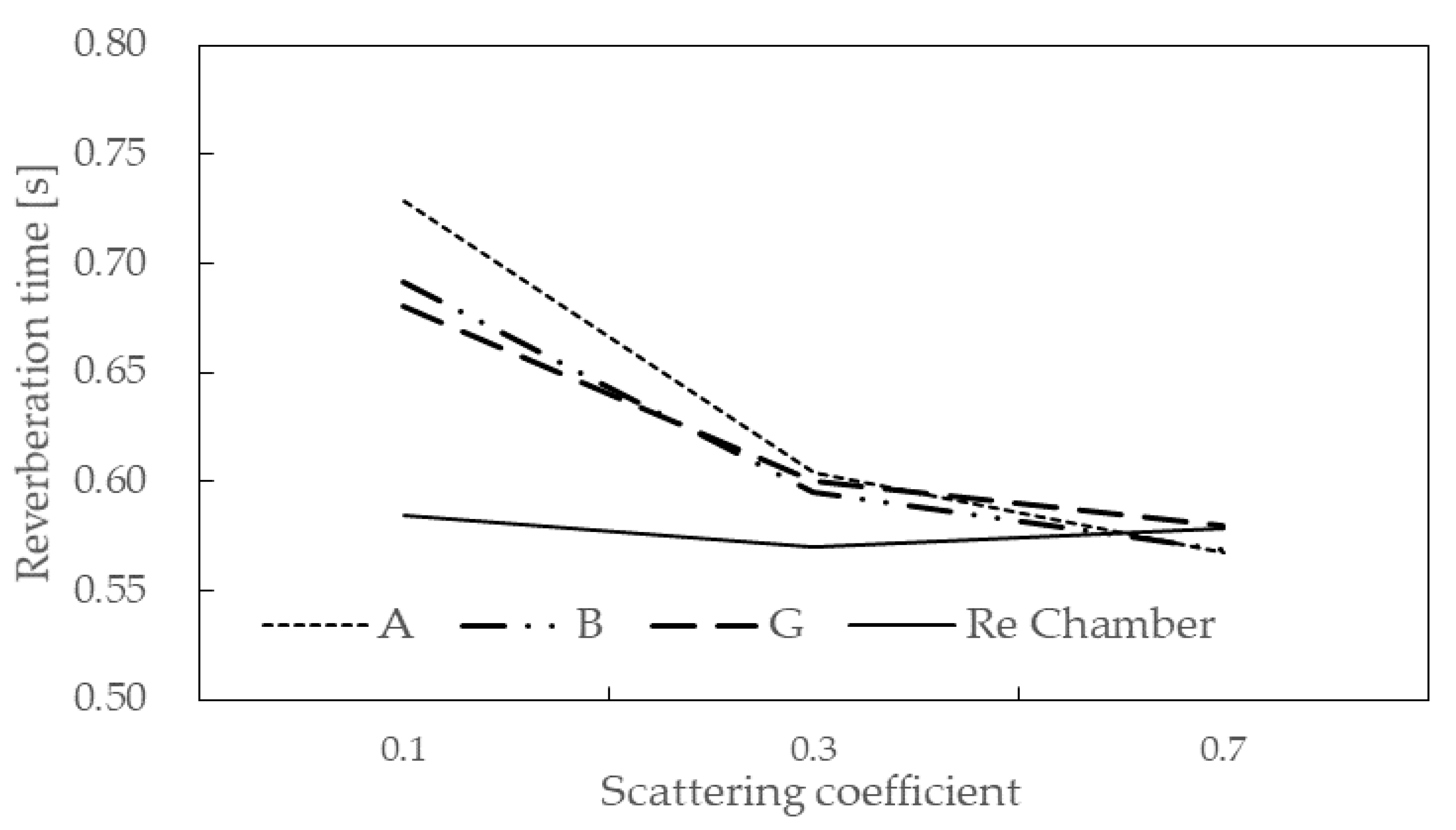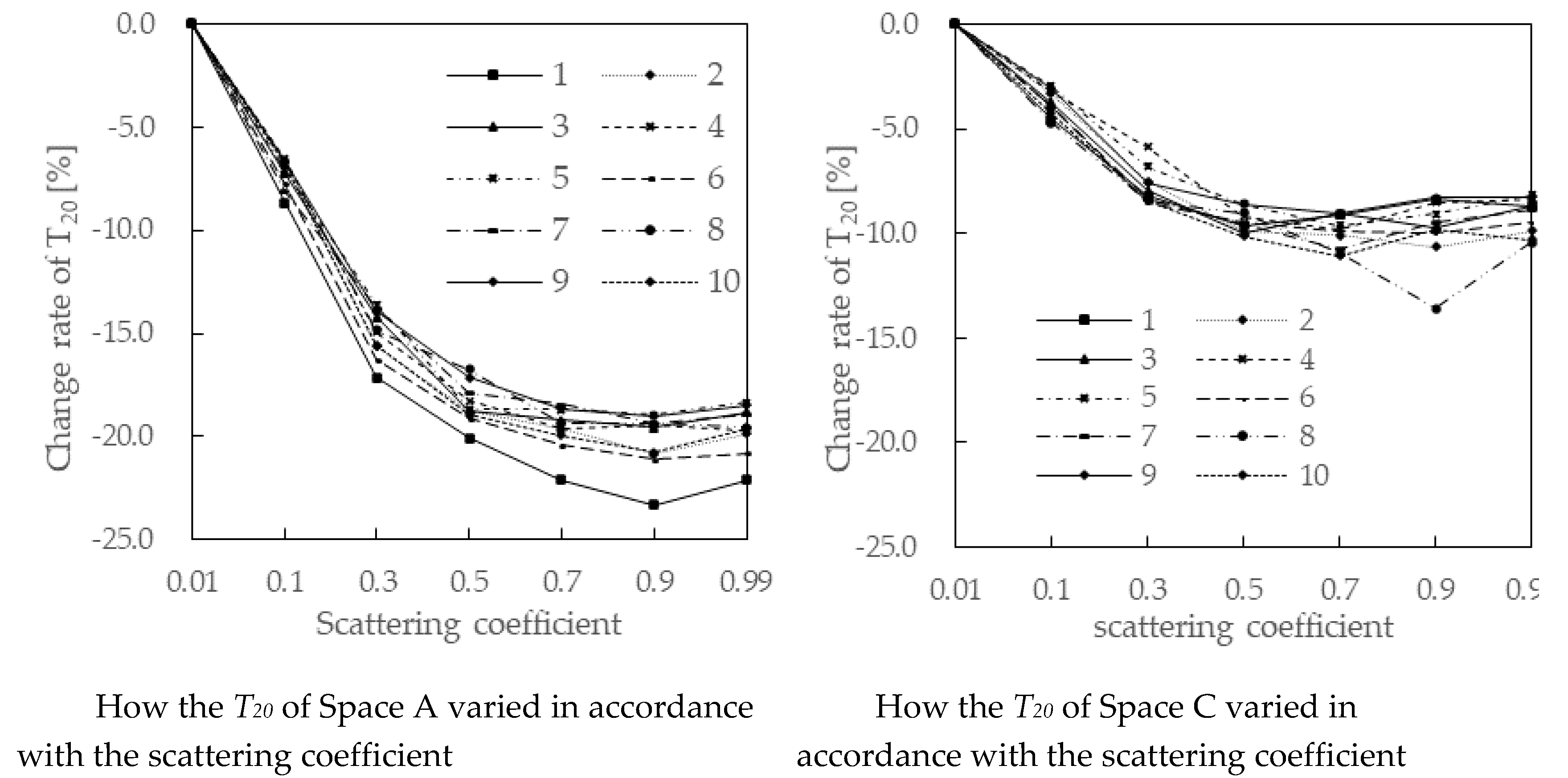1. Introduction
In the acoustic design of performance buildings, walls and ceilings are usually fitted with diffusion devices to diffuse indoor sound fields. The acoustic reflection, which results from the tilt or concave/convex shape of surfaces, changes the transmission direction of sound energy and the distribution of resonance frequency in indoor spaces. The diffusion of indoor sound fields is considered a very important method of improving acoustic quality [
1].
Two parameters describe the reflection state of sound on surfaces, the diffusion coefficients and scattering coefficients. The scattering coefficient refers to the ratio of the non-specular reflection energy to the total reflection energy, while the diffusion coefficient is used to describe the spatial polar distribution of non-specular reflection sound energy [
2,
3]. The difference between diffusion coefficient and scattering coefficient is that diffusion coefficient describes the spatial distribution of non-specular sound energy, while scattering coefficient describes the energy proportion of non-specular sound energy. Cox et al. [
4] found that using the diffusion coefficients in geometric room acoustic models is likely to produce incorrect results. In this paper, the scattering coefficient was used. To evaluate the effect of diffusion and scattering, a key room acoustics parameter is reverberation time (
RT), determined by 20 dB decay or 30 dB decay, specifically referred to as
T20 and
T30, respectively in this paper, whereas
RT refers to general concept of reverberation time.
Previous studies have investigated the impact of surface scattering on the acoustic quality of performance buildings using three methods: subjective surveys, computer simulations, and scale-model tests. By assigning values to the concavity or convexity of the walls and ceilings of concert halls, Haan [
5] conducted a subjective survey, concluding that the scattering state of walls and ceilings was highly correlated (or to be more specific, positively correlated) with concert-hall evaluation scores. However, high acoustic quality was not analyzed in detail in these evaluations. In terms of the overall diffusion sound field of each space, the inherent diffusivity of the space and the scattering coefficient of the indoor surface work jointly to diffuse sound energy. In the acoustic design of concert halls, numerous decorative “shoeboxes” and irregularly shaped “vineyards” in the walls and ceilings are thought to play an important role in diffusing sound fields [
6]. The recognition of sound scattering by human ears is a very important index for acoustic design; during the process of constructing performance buildings, the design pattern of surface scattering affects the architectural design, decoration design, and construction cost. Vitale [
7] and Seo et al. [
8] studied surface diffusion through computer simulations and scale-model tests. Using a computer simulation of Dortmund Concert Hall, Vitale [
7] found that the average scattering coefficient variation perceived by listeners was 0.6. However, Vitale did not further investigate the relationship between scattering and acoustic parameters.
In terms of the study of objective parameters, Seo et al. [
8] found that
RT decreased by 0.1 s when diffusers were added to the side walls of Miral Concert Hall. Using the scale-model method, Jeon and Sakurai studied the impact of side wall scattering. Based on a 1/10 scale model and also a real performance hall, Jeon et al. [
9] compared two states (diffusion and reflection) of wall surfaces; they found that adding diffusers reduced the standard error of early decay time, and increased the quantity of high-frequency reflected sound peaks. Using a 1/10 scale model, Sakurai [
10] compared acoustic parameters before and after adding cylindrical diffusers in a leaf-shaped concert hall, finding that the difference in sound pressure level of the 1/3 octave (1000 Hz) between seats increased from 5 to 7 dB after diffusers were added to the walls. For seats close to the walls, the initial delay increased from 9 to 37 ms. Using the scale-model method, Ryu and Jeon [
11] carried out a comparative study before and after adding diffusers to nearby side walls of the Gold Sea Art Gallery multifunctional hall; the diffusers reduced the initial delay, the energy intensity of first-order reflected sound, the sound pressure level,
RT, and early decay time (
EDT). Based on a scale model, Jeon [
12] used reflecting materials to block the diffusers on nearby side walls, finding that the diffusers served to reduce the standard errors of interaural cross-correlation coefficient (
IACC) and early decay time (
EDT). All of the aforementioned studies examined a single space and made no comparisons between multiple spaces.
In an article on scattering, Hodgson [
13] argued that, in a room with specular reflection, sound decay would not be linear and the slope of time-decaying sound energy would be lower than predicted by Eyring. In a room with high diffusivity, however, the slope of time-decaying sound energy would present more linear characteristics. In a space with uniform acoustic absorption, the proportion of three dimensions would affect the decay of sound energy; specifically, the effect of surface scattering on the decay of sound energy would vary in accordance with the relative proportions of three dimensions. The diffusion effect of the sound field would be affected by spatial shape, as well as the shape of the diffuser. Yokota et al. [
14] added diffusers to same-area surfaces in three spaces (the first rectangular, the second sectorial, and the third elliptical); the calculation results confirmed the above arguments. Kuttruff [
15] investigated the relationship between diffused reflection and
T30 in a sound ray tracing model; they found that when wall surfaces were tilted, linear decay was caused by a low scattering coefficient. However, tilted wall surfaces alone do not diffuse indoor sound fields. Sakurai’s [
10] findings show that the impact on sound fields varies in accordance with the position and quantity of diffusers. Wang [
16] conducted a comparative study before and after increasing the diffusion of the concert hall’s side wall using the scale model test method and found that when the side wall increases sound diffusion, the room’s
T30 decreases. Using a 1/50 scale model, Kim et al. [
17] found that, in both shoebox-shaped and sectorial performance spaces, the
RT decreased as the diffusivity increased. These studies show that spatial shape and surface scattering coefficients work together to affect acoustic parameters. However, none of these studies investigated the relationship between spatial shape and surface scattering, or between spatial volume and surface scattering.
It can be seen from the above research that the influence of surface scattering change on the RT is different in different shapes of space. It can be concluded that different spatial forms can “diffuse” the energy of sound field to a certain extent, and the diffusion of sound field is affected by both spatial forms and surface scattering.
Both the scale model test and computer simulation can be used to study scattering. Using the scale model method, although the results can be close to real situations, the number of cases that can be studied is limited due to the modelling complexity. All of the studies mentioned above pertained to a single space, in which there were scattering sources or not; none compared multiple spaces of different shapes. Currently, no existing study on surface scattering has investigated the sensitivity of RT to surface scattering in differently shaped spaces and the extent to which RT varies in accordance with spatial volume.
The present study thus aims to investigate the impact of scattering on RT in differently shaped spaces. Under the conditions of a constant absorption coefficient, RT is also affected by spatial volume.
This study has mainly conducted analyses relating to the following topics:
(1) In spaces of different shapes, the way in which RT varies with an increase in the surface scattering coefficient;
(2) Under the same surface scattering coefficient, different spatial shape will have different RT;
(3) In spaces with different volumes, the way in which RT varies with an increase in the surface scattering coefficient.
4. The Impact of Spatial Shape on the T20 Change Rate
Figure 5 presents the calculation results, with the abscissa indicating the surface scattering coefficient and the ordinate indicating the
T20 change rate. The curve in
Figure 5 shows how the
T20 change rate varied as the surface scattering coefficient increased. The ordinate value was consistent with the just noticeable difference (
JND) value of
T20 at a regular interval of 5% [
23,
24,
25,
30]. As shown in
Figure 5,
T20 tended to decrease as the scattering coefficient increased in differently shaped spaces. This variation trend is consistent with existing study results [
8,
11,
14,
16,
21]. However, the decreasing trend was different across different spatial shapes.
The
T20 decay curves in
Figure 5 can be roughly classified into four groups. Within each group, the decay curves shared a similar variation trend; the variation trend of the decay curves was obviously different across groups. The more surfaces were spatially changed, the lower the RT change rate from increased surface scattering became.
In accordance with the space adjustment described above, the rectangular space was adjusted in three ways. First, the rectangular space remained unchanged, and was marked Space A. Second, the walls or ceiling were tilted separately; specifically, a single side wall was tilted, both side walls were tilted, the rear wall was tilted, and the ceiling was tilted. Spaces B, C, D, E, and F were obtained in this way. Third, both walls and the ceiling were adjusted at same time. Specifically, a single side wall and the ceiling were adjusted; both side walls and the ceiling were adjusted; and rear walls and a ceiling were added to both side walls. Spaces G, H, and I were obtained in this way. In each group of spaces, the curves of the T20 change rate shared a similar trend; the maximum difference in the change rate was less than 3% and the difference in the change rate between groups was approximately 5%. Evidently, each group of spaces shared a consistent change-rate trend, while the change-rate trend was obviously different across groups.
T20 varied most significantly in relation to the scattering coefficient in Space A. T20 change rate tended to decrease evenly; it decreased most significantly (by 25%) when the scattering coefficient was 0.9. In Spaces B, C, E, and F, the T20 change rate was approximately the same under four states, and the maximum decrease in the T20 change rate was approximately 20%. In Spaces D, G, H, and I, the T20 change rate was approximately the same under three states, and the maximum decrease in the T20 change rate was approximately 20%. In the reverberation chamber, the T20 change rate with the scattering coefficient was less than 3%.
The curves of the
T20 change rate shown in
Figure 5 presented a dual-slope trend, with 0.3 as the demarcation point. When the scattering coefficient ranged between 0.01 and 0.3,
T20 presented a stage of rapid decrease; the maximum change to
T20 (17%) occurred in the rectangular space. The minimum change to
T20 was 8%. Both were greater than 5%. When the scattering coefficient ranged between 0.3 and 0.99, the
T20 change tended to be smooth, while the
T20 change rate was always lower than 5%.
5. Impact of the Scattering Coefficient on T20
Four spaces were selected to compare
T20 values. The selected spaces included the perfect diffusion reverberation chamber, the rectangular space, a space with adjusted walls, and a space with adjustments to both walls and ceiling. In the four spaces, the surface scattering had three states (the surface scattering coefficient was 0.01, 0.3 and 0.7).
Figure 6 shows the calculation results.
As shown in
Figure 6, the
T20 varied in accordance with the scattering coefficient across the four spaces. As the scattering coefficient increased, the
T20 decreased in three spaces (apart from the reverberation chamber); the
T20 change range was different across the four spaces. Space A had the largest change range. The change ranges of Spaces B and G were smaller than Space A. When the scattering coefficient was low (0.01), the
T20 differed most among the four spaces. Specifically, the
T20 in Space A was approximately 1.23 times that in the reverberation chamber, while the
T20 in Spaces B and G were approximately 1.17 times that in the reverberation chamber. As the scattering coefficient increased, the difference in
T20 across the four spaces gradually decreased. When the scattering coefficient was 0.3, the
T20 in Spaces A, B and G were approximately 1.05 times that in the reverberation chamber. When the scattering coefficient increased to 0.7, the
T20 was basically the same across the four spaces.
The above analysis shows that, under the same surface scattering coefficient, T20 varied in accordance with spatial shapes. When the surface scattering coefficient was low, the T20 varied significantly. The inherent diffusivity of each space obviously affected the T20. The more parallel surfaces existed within a space, the lower the diffusivity of that space, and the more significantly the T20 varied. As the surface scattering coefficient increased, the inherent diffusivity of each space affected the T20 less significantly, and the T20 in all other spaces tended to be consistent with that in the reverberation chamber.
6. The Impact of Spatial Volume on the T20 Change Rate
Typical Spaces A and C were selected to be scaled up. While their spatial shapes remained unchanged, their volume gradually increased by a factor of 1.0, 2.0, 3.0, 4.0, 5.0, 6.0, 7.0, 8.0, 9.0, and 10.0, thus ranging from 3000 to 30,000 m3. During the calculation process, the average acoustic absorption coefficient was 0.5.
The
T20 change curve related to Space A basically coincided with that related to Space C. The maximum
T20 change rate related to Space A was 0.23, and the difference in the maximum
T20 change rate was 4% between different volumes. The maximum
T20 change rate related to Space C was 13.5%. Except for one or two numerical values, the difference in the maximum
T20 change rate was 4% between different volumes. Evidently, the impact of the surface scattering coefficient on
T20 was weakly correlated with spatial volume when the spatial volume ranged between 3000 and 30,000 m
3 (as shown in
Figure 7).
7. Definition of Morphology Diffusivity
Figure 2,
Figure 3,
Figure 4,
Figure 5,
Figure 6 and
Figure 7 show that as the surface scattering coefficient increased, the
T20 tended to decrease. During this process, the slope of the curve changed constantly until the curve became horizontal, presenting a dual-slope trend overall. However, the sensitivity of
T20 to the surface scattering coefficient varied across different spatial shapes. The maximum decay decreased as the tilt area increased. For the standard reverberation chamber, the surface scattering coefficient had almost no effect on
T20. As yet, no standard has been established to measure spatial diffusivity. For this reason, it is necessary to introduce the concept of “Morphology Diffusivity”.
Kuttruff [
15] calculated
RT by increasing the scattering coefficient, showing that, as the scattering coefficient increased, the decay of sound energy was approximated to the linear decay assumed by the Eyring equation. In a single space study, Wang [
28] calculated
T30 under a scattering coefficient of 0; the difference between this
T30 and the
T30 calculated using the Eyring equation became the sensitivity index of the scattering coefficient.
For spaces with the same volume but different shapes, the variation trend of
T20 with the scattering coefficient was different if the acoustic absorption coefficient remained the same. The difference in the variation of
T20 may have been due to differences in the diffusivity of spatial shapes. The results in
Figure 6 show that the
T20 change rate was associated with the composition of surface tilt. Spatial surfaces were divided into two groups, including walls and ceilings. When a single group of surfaces changed (e.g., walls only or ceilings only were adjusted), the
T20 change rate was the same, and no perfect diffusion sound fields were generated. When both groups of surfaces changed, the
T20 change rate was the same, but differed significantly from the
T20 change rate for the first group of surfaces. Likewise, no perfect diffusion sound fields were generated. When both walls and ceilings were tilted, and diffusion shapes were added to their surfaces, perfect diffusion sound fields were generated in the spaces. When only spatial volume was changed, the
T20 variation trend remained unchanged. Hence, morphology diffusivity can be defined as the inherent degree of diffusion of different spatial shapes.
Morphology diffusivity can be divided into four grades by the change amplitude of
T20 (as listed in
Table 2). Grade I stands for the morphology diffusivity of rectangular spaces. Rectangular spaces are reference spaces. However, the six planes of each rectangular space are three groups of parallel planes, so rectangular spaces are imperfect diffusion spaces. After the walls or ceilings of rectangular spaces were tilted, the morphology diffusivity of the new spaces became superior to that of the original rectangular spaces. The morphology diffusivity of such spaces was defined as Grade II. After both the walls and ceilings of rectangular spaces were tilted, the morphology diffusivity of the new spaces was further improved. The morphology diffusivity of such spaces was defined as Grade III. After diffusers were added to both the walls and the ceilings of reverberation chambers, perfect diffusion sound fields were generated. The morphology diffusivity of the reverberation chambers was then defined as Grade IV, and the reverberation chambers were perfect diffusion spaces.
Morphology diffusivity was classified into four grades, ranging from I to IV. Grade I represented the lowest level of morphology diffusivity, while IV indicated the highest level of morphology diffusivity.
While
T20 decreased as the scattering coefficient increased, there were two sections of different slopes in the change rate curve. As the scattering coefficient increased,
T20 first decreased rapidly, with a change rate greater than 5%; then,
T20 varied smoothly, with a change rate less than 5%. Hence, the inflection point of the slope was determined to be the critical scattering coefficient. For the samples used in this study, the critical scattering coefficient of the reverberation chamber was 0.01, and the critical scattering coefficients of the other spaces were 0.3. This confirmed the results of an earlier investigation by Wang [
28] and Lam [
38].
8. Conclusions
This study investigated the impact of surface scattering on T20 in differently shaped spaces. A rectangular space was used as the reference space model. On this basis, spatial shapes were adjusted.
The T20 was affected by both the inherent morphology diffusivity and surface scattering coefficient. When the morphology diffusivity was high, reflections were reflected in different ways, and the surface scattering coefficient only slightly affected the T20. For example, the T20 in the reverberation chamber did not vary with the surface scattering coefficient due to the complex shape. However, the surface scattering coefficient significantly affected the T20 when the morphology diffusivity was low. For example, in the rectangular space, the T20 change rate was 25% when the surface scattering coefficient changed. The morphology diffusivity could be re-graded by adjusting the quantity and positions of the tilted walls and ceilings. Therefore, the morphology diffusivity grades accurately described the aforementioned analysis.
For imperfect diffusion spaces, such as a rectangular space, there is a turning point in each curve of the change rate of the T20. The scattering coefficient at the inflection point is the critical scattering coefficient. For spaces such as the rectangular space, the critical scattering coefficients were all 0.3; in the reverberation chamber, the critical scattering coefficient was 0.01. Evidently, no critical scattering coefficients exist in perfect diffusion spaces, although they do exist in imperfect diffusion spaces. The results of this study show that the critical scattering coefficients of imperfect diffusion spaces are approximately 0.3.
The morphology diffusivity of space is proposed. The morphology diffusivity of space can be assigned according to the combination of different surfaces in space. Each morphology diffusivity value corresponds to a diffusion degree level, and different levels correspond to different maximum change rates of the T20. For example, when the wall or ceiling is inclined separately, it corresponds to Grade II; when the wall and ceiling are inclined at the same time, it corresponds to Grade III. The RT’s accuracy can be improved according to the morphology diffusivity and the scattering coefficient in the RT calculations of performance spaces.
In spaces with different volumes, the impact of the surface scattering coefficient on T20 is unaffected by the size of spatial volume; specifically, inherent morphology diffusivity is not affected when spatial volume ranges between 3000 and 30,000 m3.
In this study, only the uniform arrangement of sound absorption coefficients was assessed; the uneven distribution of sound absorption coefficients will be researched in the future.

